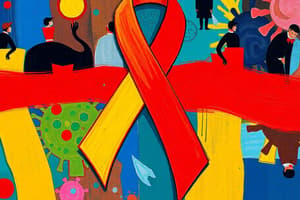Podcast
Questions and Answers
What is the primary mode of transmission of HIV?
What is the primary mode of transmission of HIV?
- Sharing needles during intravenous drug use
- Sharing food or drinks
- Contaminated blood transfusions
- Unprotected sexual contact (correct)
What are the three main stages of HIV infection?
What are the three main stages of HIV infection?
- Acute infection, chronic infection, AIDS
- Acute infection, clinical latency, chronic infection
- Chronic infection, clinical latency, AIDS
- Acute infection, clinical latency, AIDS (correct)
What is the CD4+ T cell count threshold for an AIDS diagnosis?
What is the CD4+ T cell count threshold for an AIDS diagnosis?
- 100 cells per µL
- 300 cells per µL
- 400 cells per µL
- 200 cells per µL (correct)
What is the most effective way to prevent HIV transmission?
What is the most effective way to prevent HIV transmission?
What is the recommended treatment for people of all ages with HIV/AIDS?
What is the recommended treatment for people of all ages with HIV/AIDS?
What is the most common opportunistic infection associated with AIDS?
What is the most common opportunistic infection associated with AIDS?
What is the primary cause of death from HIV/AIDS?
What is the primary cause of death from HIV/AIDS?
What is AIDS denialism?
What is AIDS denialism?
What is the current status of a licensed vaccine for HIV/AIDS?
What is the current status of a licensed vaccine for HIV/AIDS?
Flashcards
HIV transmission routes
HIV transmission routes
HIV is primarily transmitted through unprotected sex, contaminated needles, blood transfusions; and from mother to child during pregnancy, delivery, or breastfeeding.
Stages of HIV infection
Stages of HIV infection
Acute infection, clinical latency, and AIDS mark the progression of HIV.
Clinical latency
Clinical latency
The stage of HIV where few or no symptoms are present for a period of years.
AIDS definition
AIDS definition
Signup and view all the flashcards
Opportunistic infections
Opportunistic infections
Signup and view all the flashcards
Antiretroviral therapy (ART)
Antiretroviral therapy (ART)
Signup and view all the flashcards
HIV-1 vs HIV-2
HIV-1 vs HIV-2
Signup and view all the flashcards
Pre-exposure prophylaxis (PrEP)
Pre-exposure prophylaxis (PrEP)
Signup and view all the flashcards
Vertical transmission
Vertical transmission
Signup and view all the flashcards
Study Notes
Spectrum of Conditions Caused by HIV Infection
-
HIV/AIDS is a spectrum of conditions caused by infection with the human immunodeficiency virus (HIV), a retrovirus.
-
HIV is spread primarily by unprotected sex, contaminated hypodermic needles or blood transfusions, and from mother to child during pregnancy, delivery, or breastfeeding.
-
There are three main stages of HIV infection: acute infection, clinical latency, and AIDS.
-
Acute HIV symptoms include fever, large tender lymph nodes, throat inflammation, a rash, headache, tiredness, and/or sores of the mouth and genitals.
-
Clinical latency can last from about three years to over 20 years without treatment and is characterized by few or no symptoms.
-
AIDS is defined as an HIV infection with either a CD4+ T cell count below 200 cells per µL or the occurrence of specific diseases associated with HIV infection.
-
People with AIDS have an increased risk of developing various viral-induced cancers, including Kaposi's sarcoma, Burkitt's lymphoma, primary central nervous system lymphoma, and cervical cancer.
-
HIV is spread by three main routes: sexual contact, significant exposure to infected body fluids or tissues, and from mother to child during pregnancy, delivery, or breastfeeding.
-
The most frequent mode of transmission of HIV is through sexual contact with an infected person, and the risk of transmission is higher in low-income countries.
-
Blood-borne transmission can occur through needle-sharing during intravenous drug use, needle-stick injury, transfusion of contaminated blood or blood product, or medical injections with unsterilized equipment.
-
HIV can be transmitted from mother to child during pregnancy, during delivery, or through breast milk, resulting in the baby also contracting HIV.
-
Antiretroviral treatment can slow the course of the disease and may lead to a near-normal life expectancy, but without treatment, the average survival time after infection is 11 years.Understanding HIV/AIDS: Virology, Pathophysiology, Diagnosis, Prevention, Vaccination, and Treatment
-
HIV is a retrovirus that infects components of the human immune system, primarily CD4+ T cells, macrophages, and dendritic cells.
-
There are two types of HIV: HIV-1 and HIV-2. HIV-1 is more virulent and is the cause of the majority of HIV infections globally.
-
HIV causes AIDS by depleting CD4+ T cells, weakening the immune system and allowing opportunistic infections.
-
HIV is diagnosed via laboratory testing and then staged based on the presence of certain signs or symptoms.
-
Consistent condom use reduces the risk of HIV transmission by approximately 80% over the long term.
-
Antiretroviral treatment among people with HIV whose CD4 count ≤ 550 cells/µL is a very effective way to prevent HIV infection of their partner.
-
Pre-exposure prophylaxis (PrEP) with a daily dose of the medications tenofovir, with or without emtricitabine, is effective in people at high risk.
-
Programs to prevent the vertical transmission of HIV (from mothers to children) can reduce rates of transmission by 92–99%.
-
Currently, there is no licensed vaccine for HIV or AIDS.
-
Treatment consists of highly active antiretroviral therapy (HAART), which slows progression of the disease.
-
HAART options are combinations consisting of at least three medications belonging to at least two types of antiretroviral agents.
-
Rapid initiation of antiretroviral therapy within one week of diagnosis appears to improve treatment outcomes in low and medium-income settings.HIV/AIDS is a global pandemic that has affected approximately 36.7 million people worldwide, resulting in about 1 million deaths in 2016. The primary causes of death from HIV/AIDS are opportunistic infections and cancer. The World Health Organization and the United States recommend antiretroviral treatment for people of all ages, as soon as the diagnosis is made, regardless of CD4 count. Dolutegravir/lamivudine/tenofovir is listed by the World Health Organization as the first-line treatment for adults. The effectiveness of treatment depends on compliance, which may be reduced due to poor access to medical care, inadequate social supports, mental illness, and drug abuse. The European Medicines Agency has recommended the granting of marketing authorizations for two new long-acting injectable antiretroviral medicines, rilpivirine and cabotegravir. Measures to prevent opportunistic infections are effective in many people with HIV/AIDS. South Africa has the largest population of people with HIV of any country in the world at 5.9 million. HIV/AIDS has become a chronic rather than an acutely fatal disease in many areas of the world. The first news story on the disease appeared on May 18, 1981, in the gay newspaper New York Native.HIV/AIDS: Origins, Society and Culture, Economic Impact, and Misconceptions
Origins:
- HIV-1 and HIV-2 originated from non-human primates in West-central Africa and were transferred to humans in the early 20th century.
- HIV-1 originated from a simian immunodeficiency virus (SIV) that infects wild chimpanzees, while HIV-2 originated from a virus of the sooty mangabey, an Old World monkey living in coastal West Africa.
- There is evidence that humans who participate in bushmeat activities commonly acquire SIV, but several transmissions of the virus from individual to individual in quick succession are necessary to allow it enough time to mutate into HIV.
- The most recent common ancestor of the HIV-1 M group dates back to c. 1910, and the epidemic can be linked to the emergence of colonialism and growth of large colonial African cities, leading to social changes including a higher degree of sexual promiscuity and the accompanying high frequency of genital ulcer diseases.
- Unsafe medical practices in Africa after World War II, such as unsterile reuse of single-use syringes during mass vaccination and treatment campaigns, were also a proposed initial vector that allowed the virus to adapt to humans and spread.
Society and Culture:
- AIDS stigma exists globally, including ostracism, rejection, discrimination, and avoidance of HIV-infected people, compulsory HIV testing without prior consent or protection of confidentiality, violence against HIV-infected individuals, or people who are perceived to be infected with HIV, and quarantine of HIV-infected individuals.
- AIDS stigma has been further divided into three categories: instrumental AIDS stigma, symbolic AIDS stigma, and associative AIDS stigma.
- In many developed countries, there is an association between AIDS and homosexuality or bisexuality, and this association is correlated with higher levels of sexual prejudice, such as anti-homosexual or anti-bisexual attitudes.
- AIDS affects the economics of both individuals and countries, decreasing the gross domestic product of the most affected countries due to the lack of human capital.
- AIDS causes both loss of income and increased spending on healthcare at the household level, leaving less income to spend on education and other personal or family investment.
Religion and AIDS:
- The religious approach to prevent the spread of AIDS argues that cultural changes are needed, including a re-emphasis on fidelity within marriage and sexual abstinence outside of it.
- Some religious organizations have claimed that prayer can cure HIV/AIDS.
Media portrayal:
- Many famous artists and AIDS activists campaign for AIDS education and the rights of those affected.
- Criminal transmission of HIV is the intentional or reckless infection of a person with the virus.
Misconceptions:
- There are many misconceptions about HIV and AIDS, including that AIDS can spread through casual contact, that sexual intercourse with a virgin will cure AIDS, and that HIV can infect only gay men and drug users.
- AIDS denialism, which disputes the connection between HIV and AIDS, the existence of HIV itself, or the validity of HIV testing and treatment methods, has been examined and rejected by the scientific community.
- Several discredited conspiracy theories have held that HIV was created by scientists, either inadvertently or deliberately.
Research:
- Research on HIV/AIDS has led to the development of antiretroviral therapy that can suppress the virus and prevent progression to AIDS, but there is still no cure or vaccine for HIV.
Studying That Suits You
Use AI to generate personalized quizzes and flashcards to suit your learning preferences.




